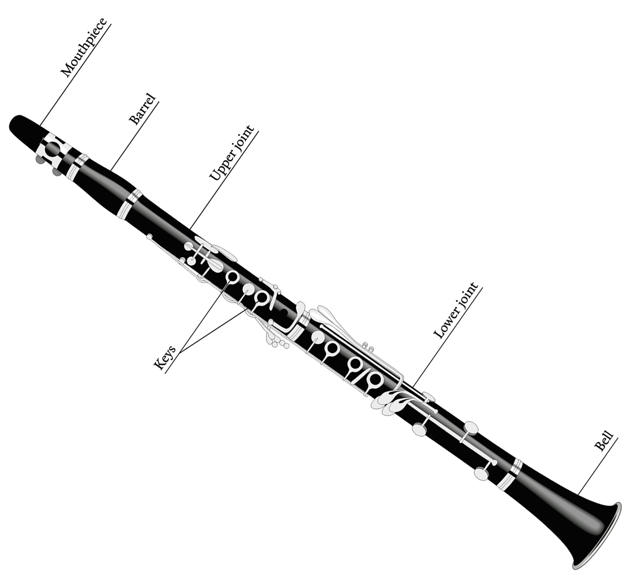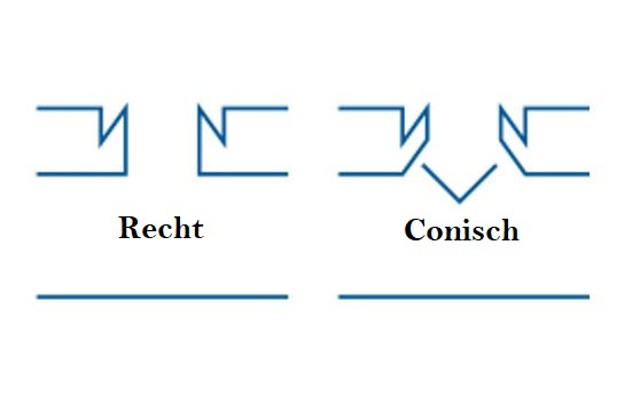Clarinet Information
To make manufacturing, transport, and maintenance easier, the clarinet consists of five separate parts that are fitted together with cork-covered tenons:
- the mouthpiece (together with the reed and ligature)
- the barrel
- the upper joint
- the lower joint
- the bell

Mouthpiece
Modern clarinet mouthpieces are usually made of hard rubber (ebonite) but also of glass, metal, or plastic. A reed rests against the mouthpiece and vibrates when blown, producing sound. Ligatures are used to clamp the reed against the mouthpiece, and they are typically made of leather or metal. Clarinetists using a clarinet with the Oehler or Albert system often use a string ligature, which they wrap around the mouthpiece and reed.
The barrel
The primary function of the barrel is to tune the instrument. Many clarinetists have different barrels of varying lengths to switch between, allowing them to adapt to the playing conditions and the pitch chosen by the orchestra. The length of the barrel and the internal bore affect the overall length of the instrument and thus the tuning. Professional clarinets are often supplied with two barrels that differ by 1mm.
The top and bottom of the body can also be pushed apart, making the instrument longer. The clarinet is very sensitive to any change in length; this not only changes the tuning but also the tone. Professionals can compensate for tuning inaccuracies by adjusting their embouchure technique. In extreme cases, using barrels of different sizes becomes unavoidable.
The body
The two parts of the body, situated between the barrel and the bell of the instrument, have holes, rings, and keys. The body is vertically drilled by the bore (internal drilling) and horizontally drilled at specific points (tone holes). The tone holes that are closed with your fingers are simple round holes, often with rings, also known as spectacles. There are several different key systems used. The rest are the tone holes that need to be closed with keys, usually because a clarinetist cannot reach these holes with their fingers. The holes for the keys are recessed and surrounded by a raised conical ring, on which the pads glued into the keys seal the holes airtight when the keys are closed. The pads are made of leather, usually soft goatskin, or Goretex.
The body of a clarinet is usually made from grenadilla wood. Besides grenadilla, boxwood and cocobolo are also commonly used. Starter clarinets are often made from ABS plastic or ebonite. In 1994, Buffet Crampon developed a composite material made of grenadilla powder and carbon fibers, which is their "Green Line" series.
The key mechanism is usually made from silver-plated or gold-plated nickel silver.
Read more about wood types here. Read more about metal types here.
Tone Holes
The shape and finish of the tone holes affect how the clarinet plays and sounds. In cheaper clarinets, the tone holes are drilled straight. In more expensive clarinets, the tone holes are usually finished conically on the inside of the clarinet, often by hand. This provides a darker sound and makes the clarinet easier to play.

The Bore
The shape of the bore, the hollowed-out part of the clarinet, is hardly visible when you look at the instrument. Yet, this shape has a significant influence on the sound. When you look through a clarinet from the top, it appears to be a straight tube that widens at the bell. However, there are indeed small differences in the bore that affect the sound. The barrel is often bored slightly wider at the bottom, and the bore gradually widens in the lower joint to become fully conical in the bell.
The Bell
The flared end of the clarinet is known as the bell. Contrary to common belief, the bell does not amplify the sound; it improves the tonal evenness of the instrument for the lowest notes. For the other notes, the sound is almost entirely produced at the tone holes, making the bell less relevant. On basset horns and larger clarinets, the bell curves upward and forward and is usually made of metal.
